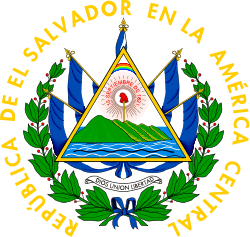Flag of El Salvador
 | |
| Name |
Tierra de Volcanes Soberbios "Land of Superb Volcanoes" (in Spanish) |
|---|---|
| Use | State and war flag, naval ensign |
| Proportion | 189:335[1], approximately 4:7 |
| Adopted | May 27, 1912 |
| Design | A horizontal triband of blue (top and bottom) and white with the National Coat of Arms centered on the white band. |
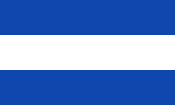 Variant flag of El Salvador | |
| Use | Civil flag |
| Proportion | 3:5 |
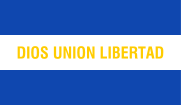 Variant flag of El Salvador | |
| Use | State and war flag, civil and state ensign |
| Proportion | 3:5 |
The flag of El Salvador features a horizontal triband of blue-white-blue, with the coat of arms centered and entirely contained within the central white stripe. This design of a triband of blue-white-blue is commonly used among Central American countries.
Features
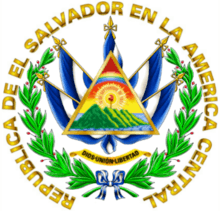
The colors signify:
- Golden Amber : represents the entire bold phraseology in the flag, the coat of arms of El Salvador; the bold equilateral triangle, 5 indigenous spears, beaming solar rays, scroll, the bold motto (God Union Liberty) and the bold etymology (Republic of El Salvador in Central America)
The flag contains the national coat of arms with the words "REPUBLICA DE EL SALVADOR EN LA AMERICA CENTRAL" (English: Republic of El Salvador in Central America). There are two variant flags, one without the coat of arms, and the other with the words "DIOS UNION LIBERTAD" (English: God, Union, Liberty) in golden amber in place of the coat of arms. All three contain the same cobalt blue and white stripes. The main flag has an aspect ratio of 189:335; the variants are both 3:5.[2]
From 1865 to 1912, a different flag was in use, with a field of alternating cobalt blue and white stripes and a red canton containing white stars. The designs of both sides of the flag are different; at the reverse side, it shows the then national coat of arms at the position of stars at obverse. The stars symbolized the provinces of the Republic; once a new province was created, one star was add to the obverse of the flag. This "Star-Striped" banner was considered to be inspired by the flag of the United States.
The blue stripes symbolize the ocean and sky. The white means Peace.
Historical Flags
.jpg)

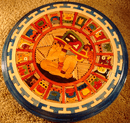
Blue is an important color in Salvadoran culture and identity. It started with Native American cultures of Mesoamerica in El Salvador, that cultivated and produced (añil) indigo plant which they used extracts to produce blue dyes. When the Europeans invaded and colonized the area, they saw the wealth of indigo and turned El Salvador to one of the world's foremost providers of indigo dye in its time. Synonymous to the country's wealth, the colonizers referred to the dye as "the blue gold", that dominated El Salvador's economy until it was completely replaced by coffee cultivation. Today El Salvador remains as one of the few countries in the world that still cultivates indigo to produce blue dyes. Over time El Salvador's flag has had several different shades of blue, from the lightest to darkest. The present current modern flag displays a Cobalt Blue tone.
 February 20, 1822 – February 10, 1823, 1841–1842, 1844 – May 9, 1865 (as part of United Provinces of Central America) (civil flag)
February 20, 1822 – February 10, 1823, 1841–1842, 1844 – May 9, 1865 (as part of United Provinces of Central America) (civil flag)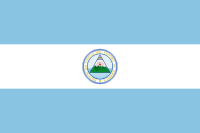
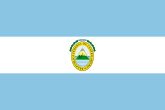
.svg.png) May 9 – June 1865
May 9 – June 1865.svg.png) June 1865 – 1869
June 1865 – 1869.svg.png) 1869–1873
1869–1873.svg.png) 1873–1877
1873–1877.svg.png) 1877 – May 17, 1912
1877 – May 17, 1912.svg.png) November 2 – November 30, 1898 (as part of Greater Republic of Central America)
November 2 – November 30, 1898 (as part of Greater Republic of Central America)_(Reverse).jpg) Flag of El Salvador (1865–1877)(Reverse side)
Flag of El Salvador (1865–1877)(Reverse side)_(Reverse).jpg) Flag of El Salvador (1877–1912)(Reverse side)
Flag of El Salvador (1877–1912)(Reverse side)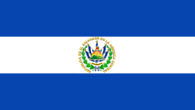 Flag of El Salvador (1912–present)
Flag of El Salvador (1912–present)
References
- ↑ "Flag of El Salvador". Encyclopedia Britannica. Retrieved 2018-10-13.
- ↑
- Art.7. "La bandera magna será de tres metros treinta y cinco centímetros de largo por un metro ochenta y nueve centímetros de ancho, en la cual irá dibujado el Escudo de Armas con todos sus blasones." (The greater flag is 3m 35cm long and 1m 89cm wide and includes the entire national coat of arms)
- Art.9. "La bandera de uso en edificios y oficinas públicos, será de un metro de largo por sesenta centímetros de ancho (..) En la franja del centro llevará la leyenda: DIOS UNION LIBERTAD" (The flag for use at public buildings is 1m long by 60cm wide (..) The central stripe shall bear the inscription 'Dios Union Libertad')
- Art.11. "La bandera de desfiles deberá medir un metro cuarenta y cinco centímetros de largo por noventa centímetros de ancho (..) La franja blanca de la bandera para desfiles, llevará en letras doradas la inscripción: DIOS UNION LIBERTAD" (The flag for use at parades will be 1.45m long by 90cm wide (..) The white stripe of the flag for parades shall bear in golden letters the inscription 'Dios Union Libertad')
